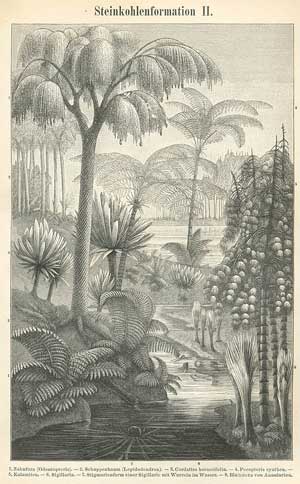
The Carboniferous Period is famous for its vast swamp forests, such as the one depicted here. Such swamps produced the coal from which the term Carboniferous, or "carbon-bearing," is derived.
The Carboniferous Period

The Carboniferous Period is famous for its vast swamp forests, such as the one depicted here. Such swamps produced the coal from which the term Carboniferous, or "carbon-bearing," is derived.
The Carboniferous Period lasted from about 359.2 to 299 million years ago* during the late Paleozoic Era. The term "Carboniferous" comes from England, in reference to the rich deposits of coal that occur there. These deposits of coal occur throughout northern Europe, Asia, and midwestern and eastern North America. The term "Carboniferous" is used throughout the world to describe this period, although in the United States it has been separated into the Mississippian (early Carboniferous) and the Pennsylvanian (late Carboniferous) Subsystems. This division was established to distinguish the coal-bearing layers of the Pennsylvanian from the mostly limestone Mississippian, and is a result of differing stratigraphy on the different continents. The Mississippian and Pennsylvanian, in turn, are subdivided into a number of internationally recognized stages based on evolutionary successions of fossil groups . These stages are (from early to late) Tournaisian, Visean, and Serpukhovian for the Mississippian — and Bashkirian, Moscovian, Kasimovian, and Gzhelian for the Pennsylvanian.
In addition to having the ideal conditions for the formation of coal, several major biological, geological, and climatic events occurred during this time. Biologically, we see one of the greatest evolutionary innovations of the Carboniferous: the amniote egg, which allowed for the further exploitation of the land by certain tetrapods. It gave the ancestors of birds, mammals, and reptiles the ability to lay their eggs on land without fear of desiccation. Geologically, the Late Carboniferous collision of Laurasia (present-day Europe, Asia, and North America) into Gondwana (present-day Africa, South America, Antarctica, Australia, and India) produced the Appalachian Mountain belt of eastern North America and the Hercynian Mountains in the United Kingdom. A further collision of Siberia and eastern Europe created the Ural Mountains of Russia. And climatically, there was a trend towards mild temperatures during the Carboniferous, as evidenced by the decrease in lycopods and large insects, and an increase in the number of tree ferns.
The stratigraphy of the Mississippian can be easily distinguished from that of the Pennsylvanian. The Mississippian environment of North America was heavily marine, with seas covering parts of the continent. As a result, most Mississippian rocks are limestone, which are composed of the remains of crinoids, lime-encrusted green algae, or calcium carbonate shaped by waves. The North American Pennsylvanian environment was alternately terrestrial and marine, with the transgression and regression of the seas caused by glaciation. These environmental conditions, with the vast amount of plant material provided by the extensive coal forests, allowed for the formation of coal. Plant material did not decay when the seas covered them, and pressure and heat eventually built up over millions of years to transform the plant material to coal.
Life
The beginning of the Carboniferous generally had a more uniform, tropical, and humid climate than exists today. Seasons if any were indistinct. These observations are based on comparisons between fossil and modern-day plant morphology. The Carboniferous plants resemble those that live in tropical and mildly temperate areas today. Many of them lack growth rings, which suggests a uniform climate. This uniformity in climate may have been the result of the large expanse of ocean that covered the entire surface of the globe, except for a localized section where Pangea, the massive supercontinent that existed during the late Paleozoic and early Triassic, was coming together.
Shallow, warm, marine waters often flooded the continents. Attached filter feeders such as bryozoans, particularly fenestellids, were abundant in this environment, and the sea floor was dominated by brachiopods. Trilobites were increasingly scarce while foraminifers were abundant. The heavily armored fish from the Devonian became extinct, being replaced with more modern-looking fish fauna.
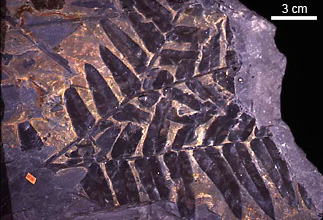 |
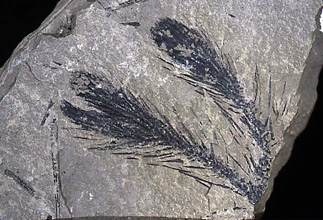 |
|
Though many spectacular plant forms dominated the Carboniferous, most of them disappeared before the end of the Paleozoic. On the left, Neuropteris, a leaf form associated with the cycad-like seed-ferns. On the right, terminal branches from Lepidodendron sternbergii, one of the great scale trees, most of which went extinct in the late Middle Pennsylvanian. |
||
Uplifting near the end of the Mississippian resulted in increased erosion, with an increase in the number of floodplains and deltas. The deltaic environment supported fewer corals, crinoids, blastoids, cryozoans, and bryzoans, which were abundant earlier in the Carboniferous. Freshwater clams made their first appearance, and there was an increase in gastropod, bony fish, and shark diversity. As the continents moved closer to forming Pangea, there was a net decrease in coastline, which in turn affected the diversity of marine life in those shallow continental waters.
Two large ice sheets at the southern pole locked up large amounts of water as ice. With so much water taken out of the water cycle, sea levels dropped, leading to an increase in terrestrial habitat. Increases and decreases in glaciation during the Pennsylvanian resulted in sea level fluctuations that can be seen in the rocks as striped patterns of alternating shale and coal layers.
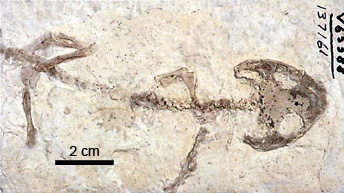 |
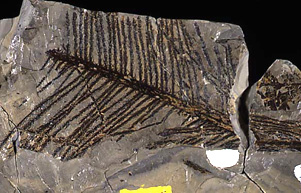 |
|
Many groups that appeared in the Carboniferous would give rise to groups that dominated the Permian and Mesozoic. On the left is Amphibiamus lyelli, an early temnospondyl. These amphibian-like early tetrapods grew to the size of crocodiles in the Permian and Triassic. On the right, Lebachia, an early relative of the conifers. |
||
The uplift of the continents caused a transition to a more terrestrial environment during the Pennsylvanian Subsystem, although swamp forests were widespread. In the swamp forests, seedless plants such as lycopsids flourished and were the primary source of carbon for the coal that is characteristic of the period. The lycopods underwent a major extinction event after a drying trend, most likely caused by increased glaciation, during the Pennsylvanian. Ferns and sphenopsids became more important later during the Carboniferous, and the earliest relatives of the conifers appeared. The first land snails appeared and insects with wings that can't fold back, such as dragonflies and mayflies, flourished and radiated. These insects, as well as millipedes, scorpions, and spiders became important in the ecosystem.
A trend towards aridity and an increase in terrestrial habitat led to the increasing importance of the amniotic egg for reproduction. The earliest amniote fossil was the lizard-like Hylonomus, which was lightly built with deep, strong jaws and slender limbs. The basal tetrapods became more diverse during the Carboniferous. Predators with long snouts, short sprawling limbs and flattened heads such as temnospondyls, like Amphibiamus (above) appeared. Anthracosaurs — basal tetrapods and amniotes with deep skulls and a less sprawling body plan that afforded greater agility — appeared during the Carboniferous and were quickly followed by diapsids which divided into two groups: (1) the marine reptiles, lizards, and snakes, and (2) the archosaurs — crocodiles, dinosaurs, and birds. The synapsids also made their first appearance, and presumably the anapsids did as well, although the oldest fossils for that group are from the Lower Permian.
Stratigraphy
The appearance or disappearance of fauna usually marks the boundaries between time periods. The Carboniferous is separated from the earlier Devonian by the appearance of the conodont Siphonodella sulcata or Siphondella duplicata. Conodonts are fossils that resemble the teeth or jaws of primitive eel- or hagfish-like fish. The Carboniferous-Permian boundary is distinguished by the appearance of the fusulinid foram Sphaeroschwagerina fusiformis in Europe and Pseudoschwagerina beedei in North America. Fusulinids are giants among protists and could reach a centimeter in length. They were abundant enough to form sizable deposits known as "rice rock" because of the resemblance between fusulinids and rice grains.
The Mississippian Subsystem is differentiated from the Pennsylvanian by the appearance of the conodont Declinognathodus noduliferus, the ammonoid genus Homoceras, and the foraminifers Millerella pressa and Millerella marblensis, though these markers apply only to marine deposits. The distinction between the Mississippian and Pennsylvanian subsystems may also be illustrated by a break in the flora due to transitional changes from a marine to a more terrestrial environment.
The stratigraphy of the Mississippian is distinguished by shallow-water limestones. Some of these limestones are composed of parts of organisms, primarily the remains of crinoids that thrived in the shallow seas. Other limestones include lime mudstones, composed of the carbonate mud produced by green algae, and oolithic limestones, composed of calcium carbonate in concentric spheres produced by high wave energy. Also found in Mississippian strata, though not as common, are sandstones (sedimentary rock composed of quartz sand and cemented by silica or calcium carbonate) and siltstones (rock composed of hardened silt).
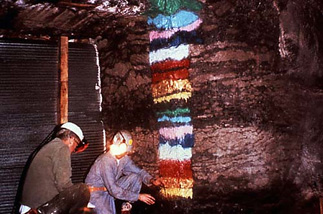 |
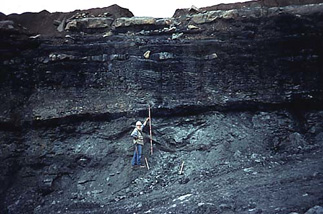 |
|
At left, scientists in a coal mine have color coded the successive layers of coal ball formation. Each layer represents an individual flood event in the coal swamp. On the right, a scientist observes the evidence of glacial and interglacial strata in Kansas. Glacial periods result in lowered ocean levels, while interglacial periods result in a rise in ocean levels, covering the continental shelf with shallow seas. |
||
Coal beds, which can be up to 11 to 12 meters thick, characterize the late Carboniferous. The forests of seedless vascular plants that existed in the tropical swamp forests of Europe and North America provided the organic material that became coal. Dead plants did not completely decay and were turned to peat in these swamp forests. When the sea covered the swamps, marine sediments covered the peat. Eventually, heat and pressure transformed these organic remains into coal. Coal balls, pockets of plant debris that were preserved as fossils and not converted to coal, are sometimes found within the coal layers.
Multiple transgressions and regressions of the Pennsylvanian seas across the continent can be seen in the rocks, and even counted, because they leave a telltale sequence of layers. As sea levels rise, the layers may go from sandstone (beach), to silty shale or siltstone (tidal), to freshwater limestone (lagoon), to underclay (terrestrial), to coal (terrestrial swampy forest). Then as sea levels fall, one may see a shale (nearshore tidal) grade to limestone (shallow marine) and finally to black shale (deep marine).
Index fossils are the remains of plants and animals that characterize a well-defined time span and occur over a wide range of geography. Fossils of marine life characterize the Mississippian, as shallow epicontinental seas covered the United States at that time. These fossils include solitary corals and Syringopora, tubular colonial corals. Other fossil colonial corals include Stelechophyllum and Siphonodendron. Because conodont fossils are distributed all over the world, they are utilized internationally to date Mississippian rocks.
Index fossils used for the Pennsylvanian Subsystem are fusulinid foraminifers and the pollen and spores from the coal forests prevalent during that time. The Mississippian-Pennsylvanian boundary is marked by the appearance of the fusulinid Pseudostaffella antiqua. Other fossils used to identify the early Pennsylvanian are the three ammonoid cephalopod genera Gastrioceras, Daiboloceras, and Paralegoceras, all found in marine deposits.
Localities
Joggins, Nova Scotia: This Pennsylvanian UNESCO World Heritage Site was home to early tetrapods such as Dendrerpeton.
Mazon Creek, Illinois: This site has become famous for its iron concretions preserving both plants and marine invertebrates.
Resources and references
* Dates from the International Commission on Stratigraphy's International Stratigraphic Chart, 2009.
Original concept for this page by Ben M. Waggoner, 7/2/1996; page content rewritten and completed by Angela Hoe, Azalea Jusay, Ray Mayberry, and Connie Yu as part of a Biology 1B project for Section 115 under Brian R. Speer, 5/11/1998; Sarah Rieboldt updated the pages to reflect the Geological Society of America (GSA) 1999 Geologic Timescale, 11/2002; Dave Smith recombined the content into a single page, adapted it to the new site format and made some content updates, 6/30/2011; Carboniferous forest etching is in the public domain; photographer of Neuropteris, Lepidodendron branch, Amphibiamus, and Lebachia unknown; photos of scientists in a coal mine and scientist measuring glacial and interglacial strata by Nan Crystal Arens